The Netgear Nighthawk AX4 (or RAX40) is an AX3000 wireless router that was released about a year ago and I know that Netgear has been flaunting its tri-band AX200 or the powerful AX120, but the RAX40 is the device that will most likely end up in your home, due to it being the most affordable from the series. Well, affordable is a big word for a wireless router that is not under $100, but the WiFi 6 is still new technology, so it’s mostly going to cater to the enthusiasts, therefore the eye-watering price tags; of course, the market is still adopting the new standard and you will see WiFi 6 cards on new phones and laptops.
| Netgear RT-AX3000 | |
|---|---|
| Amazon.com | Check Offer |
There is one interesting thing about the RAX40 that was not present with its higher-spec’d siblings and it’s that it is equipped with an Intel (Lantiq) chipset, instead of the Broadcom or Qualcomm platforms. Intel and the DOCSIS modems don’ have a nice history due to the Puma chip latency and jitter issues and the fact that the Netgear AX4 has a chip that’s related to Puma 7 is a valid source of concern.
That being said, just like the Asus RT-AX58U (another ‘affordable’ AX3000 router), the Netgear RAX40 uses OFDMA and it supports 1024-QAM as well as the 160MHZ channel bandwidth to significantly improve the wireless performance of your compatible clients and to ensure a greater WiFi coverage (than with the previous gen) – there’s also support for Amazon Alexa and the Google Assistant.
Note: I ran some tests prior to this review to confirm some issues that I saw with the Asus RT-AX58U and things seemed to be in order when connected to an AX client (for the most part), but I will also try to check for some hidden jitter issues.
Design
The Netgear Nighthawk RAX200, the RAX120 and the RAX80, all look the same and have those ridiculous Star Wars ship shape that gives the impression that the router may fly off when you’re not paying attention, but the Netgear RAX40 had its wings clipped, so, instead of the large upwards-pointing sides, there are just two regular looking antennas. This way, it does look more like a traditional router, but the rest of the case is still very similar to the other WiFi 6 devices from the series, featuring those two plastic wrapping that start from the side and get close together towards the middle, leaving space for the LEDs and buttons. Still on the top, but towards the rear side, Netgear added lots of cut-out areas which not only look really good, but also help a lot with the internal temperature. Besides for the middle which is glossy, the rest of the case is matte black which is quite soft to the touch (it’s also a fingerprints magnet).
Subjectively speaking, I do consider that the Netgear RAX40 has a better design than the Asus RT-AX58U, but the latter has the advantage of being a lot more compact and that’s no surprise considering that Netgear has always been about large cases (even its Orbi is among the largest WiFi systems on the market). So, at its 13.38 x 8.11 x 2.24 inches, it’s going to take some significant amount of space from your desk, but the beauty of the traditional-looking routers is that most can be mounted on the wall and so does the RAX40. The mounting holes can be found on the rear side positioned somewhere within the cluster of ventilation cut-outs which cover the bottom side almost entirely. Also on the bottom, there is an info label along with four silicone feet that have the role of keeping the router in place in case you decide that it should stay on a flat surface (the RAX40 weighs 1.32 lb).
The top and bottom ventilation cut-outs are a very welcomed addition and I saw that Netgear has included a vent grille on the rear side as well (above the ports), but is it enough for a relatively high performing router? The combination between a large case and the vent cut-outs seems to have been a successful one, so indeed, the router will not overheat, but it will become warm on the top, near the ports area. Just like with the Asus RT-AX58U, I was taken by surprise by the non-removable antennas and I know that most of you don’t really care and would not have upgraded them anyway, but there is a certain demographic that may have and again, this is not a cheap device by any means, despite being considered affordable and such an option would have been nice to have (well, the silver lining is that the antennas are very easy to move and have a large adjustability angle).
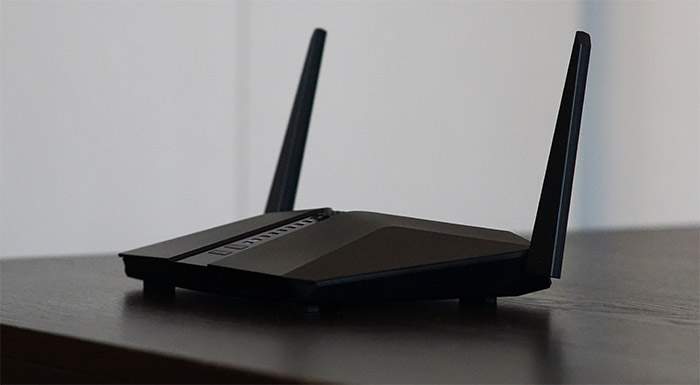
Like I said before, you get the LEDs in the middle of the case positioned in a vertical fashion, so, from the top, there’s the Power LED (if it’s flashing green, then either the firmware is upgrading or the Reset button has been pressed), the Internet LED, the 2.4GHz and the 5GHz LEDs, four LEDs, one for each LAN port (green indicates that the connection has been made at 1Gbps and amber shows that the connection has been made at 100 MBps) and a USB 3.0 port (if it flashes green, then a USB device is trying to connect). Further down there are a couple of buttons, one for turning on or off the WiFi (press and hold it for two seconds) and the other for enabling the WPS pairing process.
Moving to the rear side of the router, we find a Power On/Off button, a 12V Power port, a WAN Gigabit port, four Gigabit Ethernet LAN ports, a USB 3.0 port, a recessed Reset button (press and hold it for at least 10 seconds in order to return the device to factory default settings) and a LED On/Off switch.
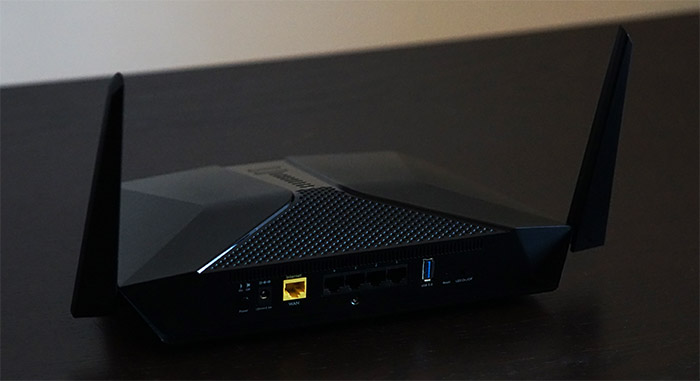
Note: It’s worth mentioning that Netgear decided to extend the bottom plastic, creating some sort of tray underneath the ports and, while it looks cool, I got myself a manicure trying to remove some Ethernet cables.
Internal Hardware
To open up the router, detach the four silicone feet to expose the four screws and, after removing them (the screws have a star head, but you can use a small flat screwdriver), make sure to also remove the screw near the ports from the rear side of the router – be aware that doing so can void your warranty. Then, gently detach the top part and you’ll be greeted by the PCB which has two heatsinks connected by spring-operated bolts; I left them like that for now and instead I detached the antennas and turned the board upside down.
Here, I saw the 256MB of storage from MXIC (Macronix a182209 MX30LF2G18AC-TI) and I could also easily remove the spring bolts that kept the heat sinks, thus exposing the chips from the other side: first, there’s the Intel AnyWAN GRX350 CPE network processor (S8503N15 SLMD9), followed by 512 MB of RAM (from Samsung), as well as a LV132A quadruple positive-NAND gate, a couple of GS5014R LF 1851M 10/100/1000 Base–T dual port magnetics modules (LAN) and a 10/100/1000 Base–T magnetics module (WAN).
As for the wireless performance, the Netgear AX3000 uses an Intel WAV654 (S8514L96 SLMRS) chip (b/g/n+ax) 2×2:2 for the 2.4GHz band (along with the Skyworks SKY85331-11 front-end module) and the Intel WAV654 chip (a/n/ac/ax) 2×2:2 for the 5GHz radio band (along with the Skyworks SKY85743:31 front-end module).
Note: The Netgear Nighthawk AX4 is advertised as being an AX3000-class router which means that it features a maximum theoretical data transfer rate of 2,400 Mbps on the 5GHz band and a maximum theoretical data transfer rate of 600 Mbps on the 2.4GHz radio band.
Netgear Nighthawk RAX40: Features and Performance
The current generation of AX wireless routers (especially, the ‘budget’ segment) is not going to deliver everything that the new WiFi standard can offer, but the RAX40 does support a few important ones, such as the well praised OFDMA (short from Orthogonal Frequency Division Multiple Access) and it’s a feature that supports a low data rate transmission simultaneously from multiple client devices – the channel gets divided into multiple sub-channels (sub-carriers) which are shared by up to 30 devices at the same time, limiting the overhead and ensuring that the bandwidth is not wasted (OFDMA works both up and downstream). You’re still going to need compatible clients to be able to take advantage of such a feature and that’s not only available for OFDMA, but pretty much the entire set of newly implemented technologies, such as 1024 QAM, 160MHz and yes, even MU-MIMO is still a part of the more pretentious group.
The 1024 QAM is basically trying to ensure a 25% data rate increase, while the 160MHz is not really that new (well, neither is the 1024 QAM, since I already saw it with the old Linksys WRT3200ACM which has gotten oddly relevant these days), but it can also ensure a far wider bandwidth and, hopefully, double the link rate. When I tested the Asus RT-AX58U, I did not saw a suitable implementation of this feature and, as you’ll see below, neither did Netgear with its ‘budget-friendly’ Nighthawk AX3000. MU-MIMO is still present and, as usual, it has the role to ensure that multiple clients are served at the same time (and not having to compete for the bandwidth) and I have to also mention the BeamForming which has the role of focusing the signal towards your compatible clients, so you get a better, more stable throughput and less interference. As you can see, the keyword is compatibility and the WiFi 6 is at a serious disadvantage right now since the market is pretty much void of 802.11ax wireless adapters.
Netgear Nighthawk RAX40
-Pros
- Cool design
- OFDMA, 160MHz and 1024-QAM
- Excellent wireless performance when everything is compatible
- More affordable than some of its competitors
Cons
- The antennas can't be removed
- Some compatibility issues with Asus PCE-AC88 and PCE-AC68
- Some mild stability issues on the 160MHz
- Slow booting time and any configuration changes take a long time to apply

Mark is a graduate in Computer Science, having gathered valuable experience over the years working in IT as a programmer. Mark is also the main tech writer for MBReviews.com, covering not only his passion, the networking devices, but also other cool electronic gadgets that you may find useful for your every day life.

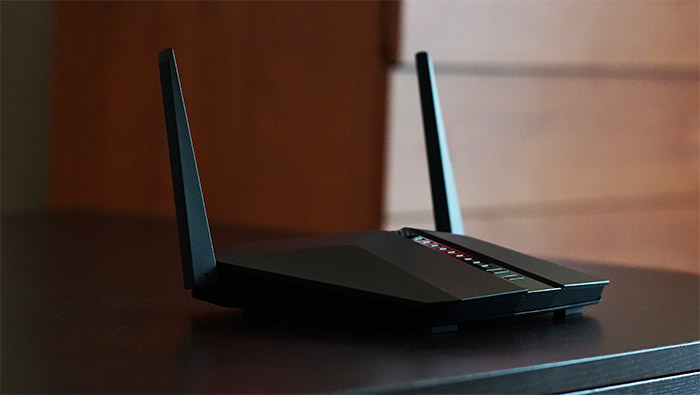
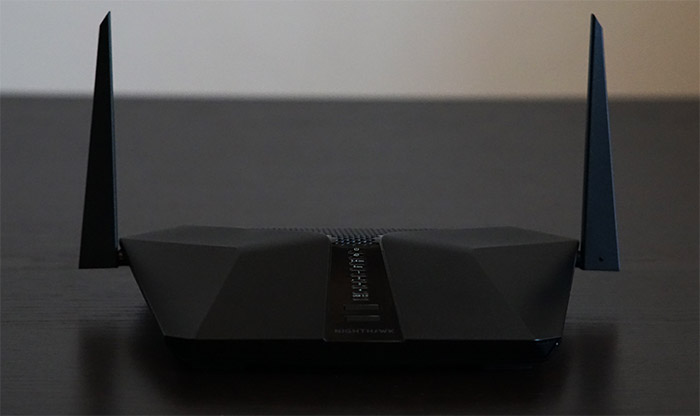
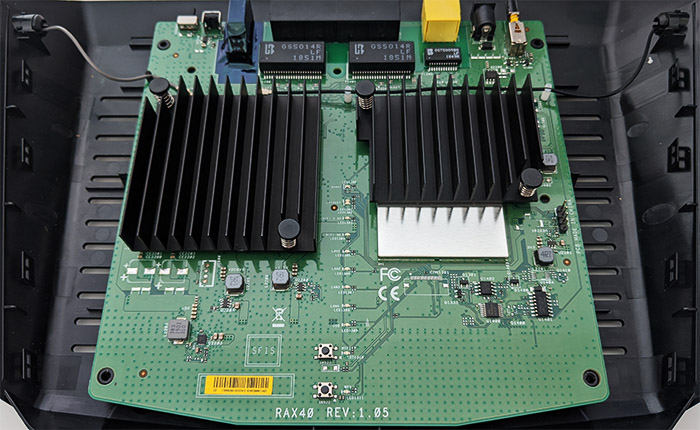
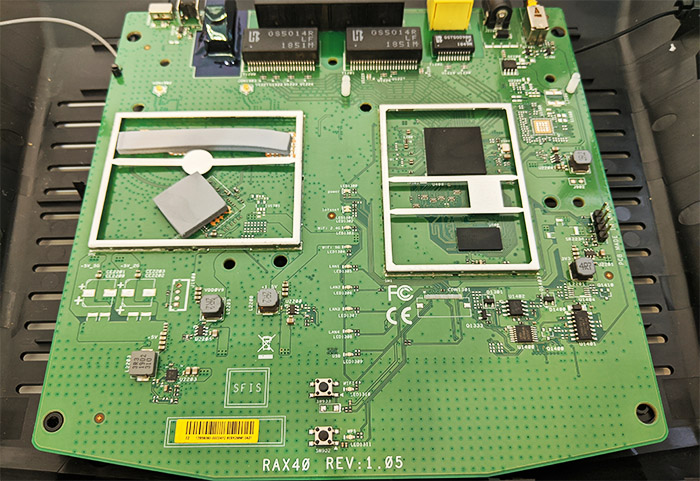

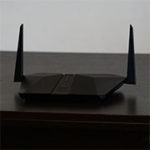
Netgear should have provided the AX4 AX3000 with 4 antennas. It could have been a formidable router. But overall, I like the Asus router better, Especially, ASUS has AIprotection for life… Not sure if AX4 has any.
I think Netgear tried to BUMP up the AX4 to AX3000, but in-comparison, it should be compared more to ASUS RT-AX1800 instead. Both has 2 antennas.
It didn’t feel like the hardware is that bad (and they’ve seriously discounted the router now), but I am more displeased by the software and the boot time which takes an unreasonable time to load and update. It feels like I returned 15 years back in time.
I have never used NETGEAR products before, but I have heard of NETGEAR bad report on software and painful setup with Netgear products.
Worst, Netgear products aren’t worth the money. They are just too expensive.
They do. its called the AX6 “AX5400”.
This is a 2×2 MIMO design on hardware level. 2 extra antennas won’t really do anything on most “AX3000” class routers. You would be better off asking for higher powered or bigger designs.
The only reason the ASUS RT-AX58U/AX3000 has 4 antennas is because the PCB is designed for multiple product SKU’s with the top end being a AX5400 design (RT-AX82U) like the AX6 “AX5400” from Netgear.
The ASUS AX58U runs at 2×4:4 according to Thiggins from smallnetbuilder and this essentially means 2 transfer 4 receive. Yes technically.. the AX58U is capable of 4T4R, but its locked and 3rd party firmware from merlin wont support unlocking it when I asked him.
Basically the 58U and this current RAX40 are in the same ballpark in terms of transfer capability. The 4 antennas don’t really help it unless the hardware itself is just better or worse. Receive? well yes.. thats better but I think thats less of a concern for performance unless uploading 🙂